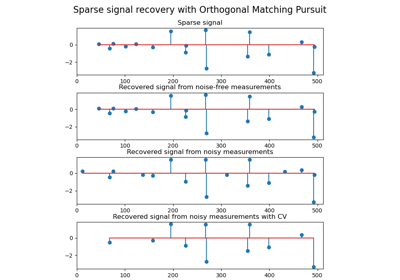make_sparse_coded_signal#
- sklearn.datasets.make_sparse_coded_signal(n_samples, *, n_components, n_features, n_nonzero_coefs, random_state=None)[source]#
Generate a signal as a sparse combination of dictionary elements.
Returns matrices
Y,DandXsuch thatY = XDwhereXis of shape(n_samples, n_components),Dis of shape(n_components, n_features), and each row ofXhas exactlyn_nonzero_coefsnon-zero elements.Read more in the User Guide.
- Parameters:
- n_samplesint
Number of samples to generate.
- n_componentsint
Number of components in the dictionary.
- n_featuresint
Number of features of the dataset to generate.
- n_nonzero_coefsint
Number of active (non-zero) coefficients in each sample.
- random_stateint, RandomState instance or None, default=None
Determines random number generation for dataset creation. Pass an int for reproducible output across multiple function calls. See Glossary.
- Returns:
- datandarray of shape (n_samples, n_features)
The encoded signal (Y).
- dictionaryndarray of shape (n_components, n_features)
The dictionary with normalized components (D).
- codendarray of shape (n_samples, n_components)
The sparse code such that each column of this matrix has exactly n_nonzero_coefs non-zero items (X).
Examples
>>> from sklearn.datasets import make_sparse_coded_signal >>> data, dictionary, code = make_sparse_coded_signal( ... n_samples=50, ... n_components=100, ... n_features=10, ... n_nonzero_coefs=4, ... random_state=0 ... ) >>> data.shape (50, 10) >>> dictionary.shape (100, 10) >>> code.shape (50, 100)
